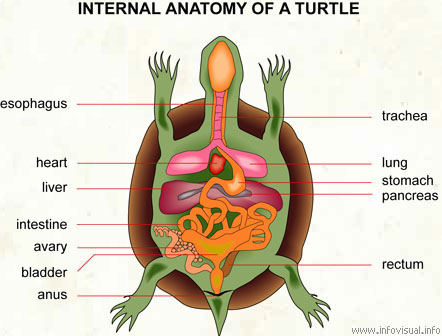|
As it states in Wikipedia, "Excertion is performed mainly by two small kidneys.
In diapsids uric acid is the main nitrogenous waste product; turtles, like mammals, mainly excrete urea. Unlike the kidneys
of mammals and birds, reptile kidneys are unable to produce liquid urine more concentrated than their body fluid. This is
because they lack a specialized structure present in the nephrons of birds and mammals, called a Loop of Henle. Because
of this, many reptiles use the colon to aid in the reabsorption of water. Some are also able to take up water stored in the
bladder. Excess salts are also excreted by nasal and lingual salt-glands in some reptiles."
Nutrition

As it states in Chelydra, "The digestive system
of turtles is not much different from other typical vertebrates.
The thick and curved stomach is attached by its side
to the very large liver. The thin-walled urinary bladder discharges into the cloaca.
The nature of the produced waste
depands on the environment in which a species lives. Tortoises from dry areas excrate virtually insoluble uric acid ( C5H4O3N4
), allowing them to save the absorbed water in large volumes in the bladder ( like Galapagos tortoises ). The semiaquatic
turtles produce relatively nontoxic and water soluble urea ( NH2CONH2 ), requiring some water for its
elimination, while the aquatic turtles excrate large amounts of ammonia ( NH3 ), a highly soluble and toxic substance
which needs large volumes of water in the process of its elimination."
Regulation
As
it states in the MSN Encarta, "Like all reptiles, turtles are ectothermic, or cold-blooded, animals that control their body
temperature by moving into or out of warm or cool places. Unlike endothermic, or warm-blooded, animals, such as mammals, turtles
do not generate heat in their bodies from digesting food. Leatherback sea turtles are an exception, as they can produce internal
heat in their muscles while swimming, and their huge size, together with a thick layer of oily fat under their skin, helps
them retain this heat. As a result, they can range into such extremely cold areas as the North Sea. Other marine turtles can
survive only in warmer waters.
Many activities of turtles help regulate their body temperatures. Aquatic turtles often leave the water to bask in the sun
on logs or rocks or along the banks of lakes and streams to warm their bodies. In winter, turtles that live in seasonal climates
enter a dormant state resembling hibernation. In this state, called torpor, the turtles stop feeding and their oxygen needs
become very low. Aquatic turtles usually remain underwater in winter, relying on their ability to obtain oxygen from water
through their skin, throat linings, and sacks within their cloaca. In contrast, land-living turtles burrow into the soil.
Eastern box turtles may spend the winter in shallow burrows;
they are able to survive partial freezing of their body fluids for several days. Young painted turtles often spend their first
winter in an underground nest. These infant turtles have the ability to survive sub-freezing temperatures for several days."
Respiratory

As
it states in MSN Encarta, "Turtles breathe air with lungs, as do other reptiles and all land-living vertebrates. Since turtle
ribs are part of their shell, turtles cannot move their ribs in and out to expand or deflate their lungs. Instead, turtles
alternately expand and contract various groups of muscles, including those in their abdomen and above their front and hind
legs, to change the amount of space within the shell. When these muscles expand, less space is available and the lungs are
compressed, permitting the turtle to exhale. A turtle takes in air as these muscles contract to provide more space into which
the lungs can expand. Many aquatic turtles remain submerged in water for periods of several hours to several days—and
for many months during winter hibernation. Many turtles are able to take in oxygen from water through the linings of the mouth,
throat, and an internal chamber called the cloaca, as well as through the skin. However, when they are active, aquatic turtles
need to rise to the surface periodically to breathe air with their lungs."
Compare & Contrast
Turtles have about the same respiratory system since the our organs are the
same but the process isn't the same. Turtles can't expand their ribs like we do so instead they do something different. They
would move thier muscles either expand them or contrast them if the turtle wants to inhale or exhale. That way when the muscles
contrast for example there would be less space in the shell and so the turtle could inhale. Then when the muscles expand it
causes less space in the shell causing the turle to exhale.
How do the differences benefit to the organism in its environment?
The excertion helps them not waste alot of water since it is
determined by the enviornment a turtle is living in. The reason because if a turtle is living in a dry enviornment then the
waste would be less water and more toxic material. A semiaquatic turtle would produce not so toxic waste which would need
little bit of water to eliminate. While the aquatic turtles produce ammonia a very toxic substince which needs alot
of water to eliminate.
|

